#kenmotsu nana too
Text
AtoZ best produce101 stage EZZZZZZZZZZZZZZZ
#murakami rinon#murakami rinon is so talented omg#produce101japanthegirls#also takami ayane is my one pick#i loveeeeee this show but im so emotional already#tabakatake momoka has improved so much too#kenmotsu nana too#kitazume sakura is so good i need her in the top 11
0 notes
Text
Nampō Roku, Book 2 (47): (1587) Eighth Month, Tenth Day, Morning.

47) Eighth Month, Tenth Day; Morning.
◦ Two-mat room.
◦ [Guests:] Maki hyōtai [牧兵太], Shiba kenmotsu [芝監物].
In all matters, everything was the same as on the second.
_________________________
¹Hachi-gatsu tō-ka, asa [八月十日、朝].
The date was September 12, 1587, in the Gregorian calendar.
On this occasion, the two guests were two of Rikyū's personal disciples -- albeit high-ranking government officials. Perhaps they were discussing the logistics of the Kitano ō-cha-no-e [北野大茶の會]; or, perhaps they were simply enjoying chanoyu at a time when there were no pressing official duties.
²Nijō shiki [二疊敷].
The two-mat room in Rikyū's official residence.
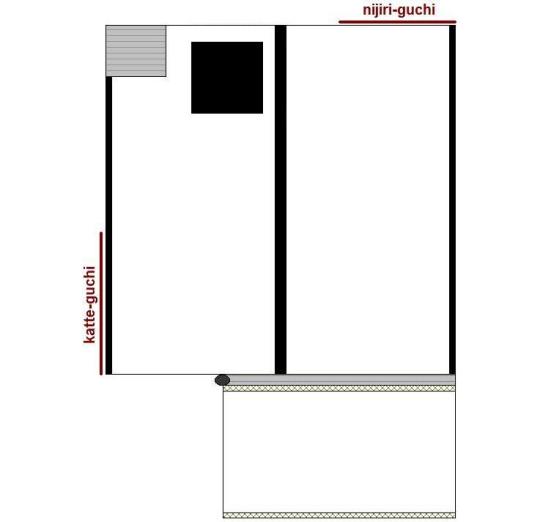
³Maki hyōtai [牧兵太].
This refers to Makimura Toshisada [牧村利貞; 1546 ~ 1593], who is also sometimes known as Makimura Masayoshi [牧村政吉]. He served as the Deputy-minister of the War Department (hyōbu-no-daisuke [兵部大輔]); and he was also one of the men whom Hideyoshi permitted to learn the gokushin-no-futatsu-gumi temae [極眞二つ組手前] from Rikyū (and so his name is usually found on the list of the Rikyū shichi-tetsu [利休七哲]). He was, therefore, a man who had earned Hideyoshi's trust.
⁴Shiba kenmotsu [芝監物].
Shibayama Shun-ichi [芝山俊一; his dates of birth and death are unknown], was also known as Shibayama Sōkō [芝山宗綱]*. He served as a kemmotsu [監物], an auditor in the Ministry of Civil Affairs; and another of Rikyū's personal disciples. Shun-ichi was also another of the men who were permitted to learn the gokushin no futatsu-gumi temae, and so his name is generally included among the Rikyū shichi-tetsu, too.
__________
*Sometimes rendered Shibayama Munetsuna [芝山宗綱], according to the usual Japanese pronunciation for personal names -- though Sōkō [宗綱] seems to have been a sort of professional "tea name."
⁵Shoji, futsu-ka dōzen [諸事、二日同前].
Shoji [諸事] means “everything.”
Therefore,
○ shoza [初座]:
◦ Kokei Sōchin's [古溪宗陳] saiji [細字] bokuseki [墨跡];
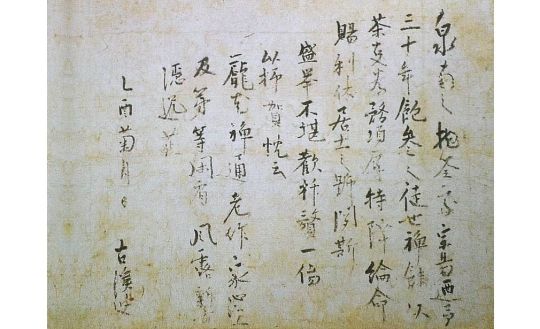
◦ the (second) small unryū-gama [小雲龍釜], arranged in Jōō's small Chōsen-buro [小朝鮮風爐];



◦ (presumably) Rikyū's ruri-suzume kōgō [瑠璃雀香合] and a go-sun-hane [五寸羽], arranged side-by-side on the tsuri-dana.

○ Goza [後座]:
◦ the chabana (the kind of flowers is not known) arranged in an oki-zutsu [置き筒], standing on an usu-ita in the middle of the toko;

As on the second day of the Eighth Month, the flower or flowers used were not specified. Most likely (since an oki-zutsu was used, meaning that the flowers would have been things that naturally are encountered in nature blooming below eye level) Rikyū would have arranged several autumnal grasses as his chabana, since it is now the beginning of that season.
The “seven grasses of autumn” (aki no nana-kusa [秋の七草]), for example, are:
- hagi [萩] (bush clover, Lespedeza bicolor]);
- obana [尾花] (also known as suzuki [芒], pampas grass, Miscanthus sinensis);
- kuzu [葛] (the kuzu vine, Pueraria montana var. lobata);
- nadeshiko [撫子] (Japanese pink, Dianthus superbus var. longicalycinus);
- ominaeshi [女郎花] (patrinia, Patrinia scabiosifolia);
- fujibakama [藤袴] (thoroughwort, Eupatorium japonicum); and.
- kikyō [桔梗] (bellflower, Platycodon grandiflorus).
And while several of these flowers were traditionally not used for chabana (ominaeshi [女郎花] and fujibakama [藤袴] are mentioned as being “forbidden from being put in a hanaire” in Jōō’s famous pair of poems; and kuzu [葛] is usually not used as well because of its extremely strong honey-like fragrance), the others were staples. If Rikyū used several flowers out of a collection (as might have been the case), he may not have remembered precisely which he used when it came time to write the details down -- and neither would he have thought detailing them that important for his records.
◦ Rikyū's Shigaraki mizusashi [信樂水指], with the hishaku resting on top, and the chaire (a ko-natsume) displayed on the mat in front of it;
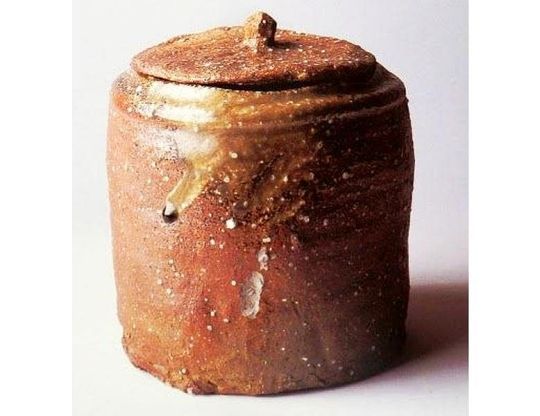
◦ ko-natsume [小棗], tied in a shifuku;
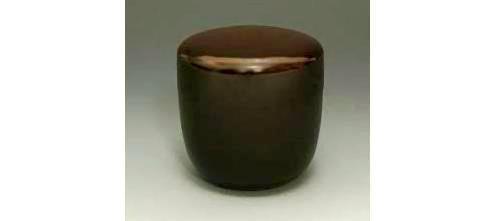
◦ the meibutsu Rinzai-in futaoki [臨濟印蓋置], placed by itself in the middle of the tsuri-dana;
◦ the Hikigi-no-saya [引木の鞘] chawan was brought out at the beginning of the koicha-temae,
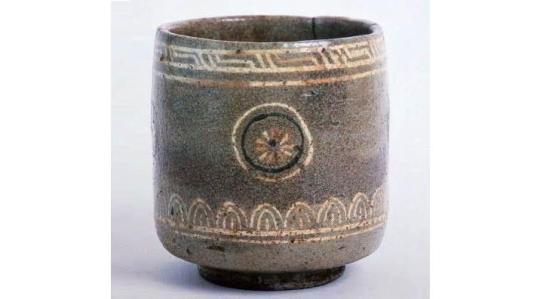
◦ with an ori-tame [折撓] resting across its mouth;

◦ the koboshi was probably a mentsū [面桶].
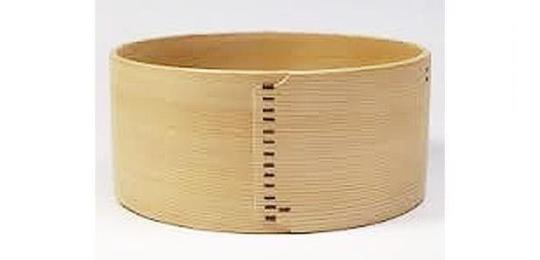
○ The kane-wari:
- the shoza was chō [調] (toko, kakemono; room, ō-ita furo; tana, kōgō and habōki, side-by-side with each touching a different kane);
- and the goza was han [半] (toko, chabana; room ō-ita furo, mizusashi with the ko-natsume placed in front and the hishaku resting on top; and the meibutsu Rinzai-in futaoki [臨濟印蓋置] in the exact center of the tana).
○ As for the kaiseki, the menu apparently consisted of:
▵ saku-saku jiru [さくさく汁] (miso-shiru containing chopped fresh greens);
▵ mozuku [海蘊] (a filamentous green seaweed, served raw, with a dressing of rice-vinegar flavored with sake and mirin);
▵ charcoal-grilled ayu [鮎];
▵ nimono [煮物], featuring matsu-take [松茸] (the pine mushroom);
▵ and as the kashi, senbei [煎餅] (rice crackers), and yaki-guri [焼き栗] (roasted chestnuts).
0 notes